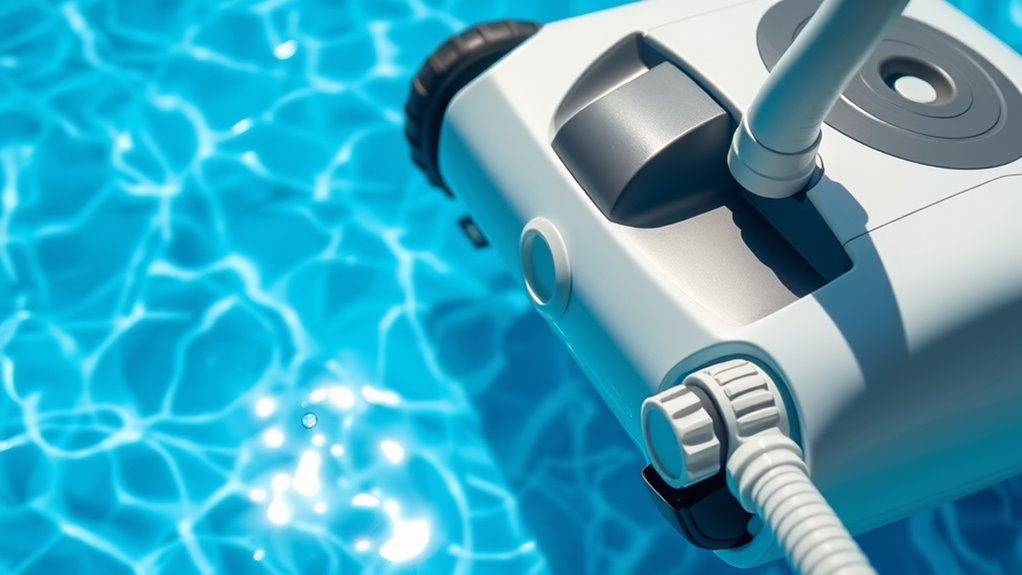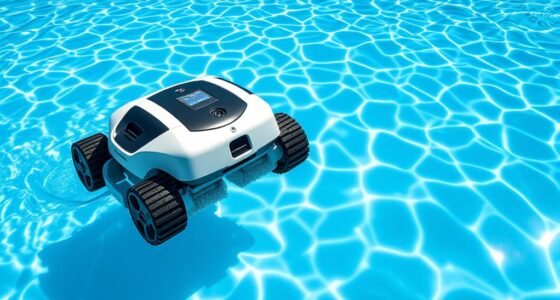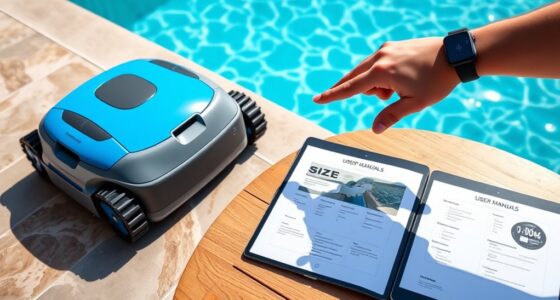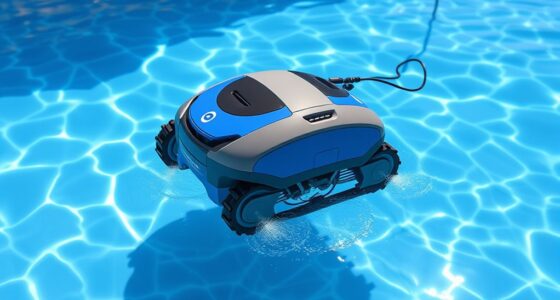To prevent suction loss in your pool cleaner, regularly check and clean the skimmer and pump baskets, removing debris before it causes blockages. Inspect hoses and connections for leaks or cracks and replace worn parts promptly. Ensure the pool water level stays at the skimmer opening and keep the cleaner’s filter and debris bag clean. Proper installation and adjusting float and weight settings help maintain ideal suction. Keep up with routine maintenance for best results—more tips follow to keep your system running smoothly.
Key Takeaways
- Regularly clean and clear all water flow pathways, including skimmer baskets and cleaner intake ports.
- Inspect hoses and connections for cracks, leaks, and proper fittings; replace or tighten as needed.
- Ensure the pool water level is maintained at the skimmer opening and use skimmer socks to reduce debris entry.
- Properly install and position the cleaner, avoiding kinks, obstructions, and ensuring secure hose attachments.
- Maintain the pool pump system, including cleaning filters and inspecting seals, to sustain optimal suction performance.
Check and Clean the Pool Skimmer and Pump Basket
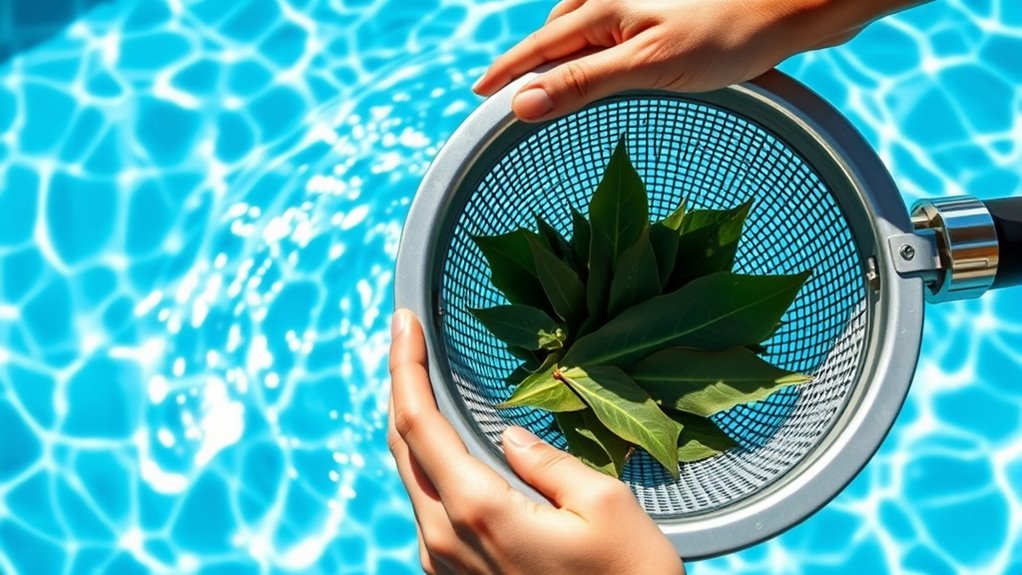
To prevent suction loss, you should regularly check and clean your pool skimmer and pump basket. These components collect debris that could clog the system and reduce flow. Start by removing the basket from the pump and skimmer. Empty out leaves, dirt, and other debris, ensuring nothing is blocking the openings. Rinse the basket thoroughly with a garden hose to remove any stubborn dirt. A clean pool skimmer and pump basket allow water to flow smoothly through the filtration system, maintaining proper suction for your pool cleaner. Regular maintenance prevents blockages that can cause suction loss, helping your pool cleaner operate efficiently. Proper filter maintenance is essential to keep your system running optimally and extend its lifespan. Incorporating routine cleaning of these components can further prevent buildup and ensure consistent performance. Additionally, inspecting the flow rate regularly can help identify potential issues early. Ensuring the system components are in good condition further supports optimal performance and minimizes the risk of suction issues. Make this routine part of your pool upkeep to keep your system running best and extend its lifespan.
Inspect and Replace Damaged or Worn Hoses and Connections

Since damaged or worn hoses and connections can cause suction loss, it’s important to regularly inspect them for signs of wear, cracks, or leaks. Look for brittle or swollen hoses, loose fittings, and corrosion around connections. If you notice any damage, perform hose replacement immediately to restore maximum suction. Connection inspection is equally essential—tighten or replace any loose or cracked fittings to prevent leaks. Use the table below to guide your inspection process:
| Hose Condition | Connection Status | Action Needed |
|---|---|---|
| Cracks or leaks | Loose or corroded | Hose replacement or connection inspection |
| Brittle or swollen | Tight or secure | Continue monitoring |
| No visible damage | Firmly connected | No action needed |
Regular checks keep your pool cleaner running efficiently. Additionally, investment in high-quality replacement hoses can help prevent future issues and improve the longevity of your pool cleaning system. Properly maintaining hoses and connections is essential for preventing suction loss, which in turn ensures efficient pool cleaning and reduces the need for costly repairs.
Ensure Proper Pool Water Level
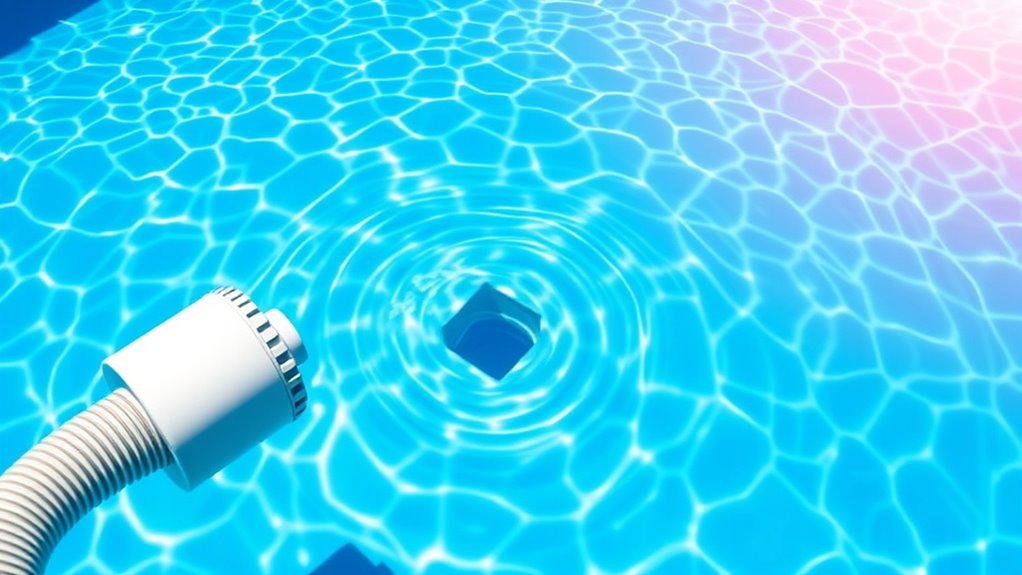
Maintaining the correct pool water level is essential for your cleaner’s ideal performance. If the water is too low or too high, it can cause suction issues and disrupt water flow. Proper water level management guarantees your cleaner operates efficiently and reduces the risk of suction loss. Check the water level regularly, especially after heavy use or rain, and adjust as needed. Keep in mind that pool water chemistry also influences water level—imbalances can affect evaporation rates. To prevent problems, consider these tips:
- Keep water at the skimmer opening level
- Regularly monitor water levels after storms
- Adjust water level before pool cleaning sessions
- Balance pool water chemistry to reduce evaporation
- Use a skimmer sock to minimize debris and water loss
- Understand how water chemistry can help develop problem-solving skills for troubleshooting pool issues
- Implement proper water testing to ensure accurate chemistry balance and prevent water level fluctuations
Clear Obstructions From the Pool Cleaner’S Intake and Suction Path
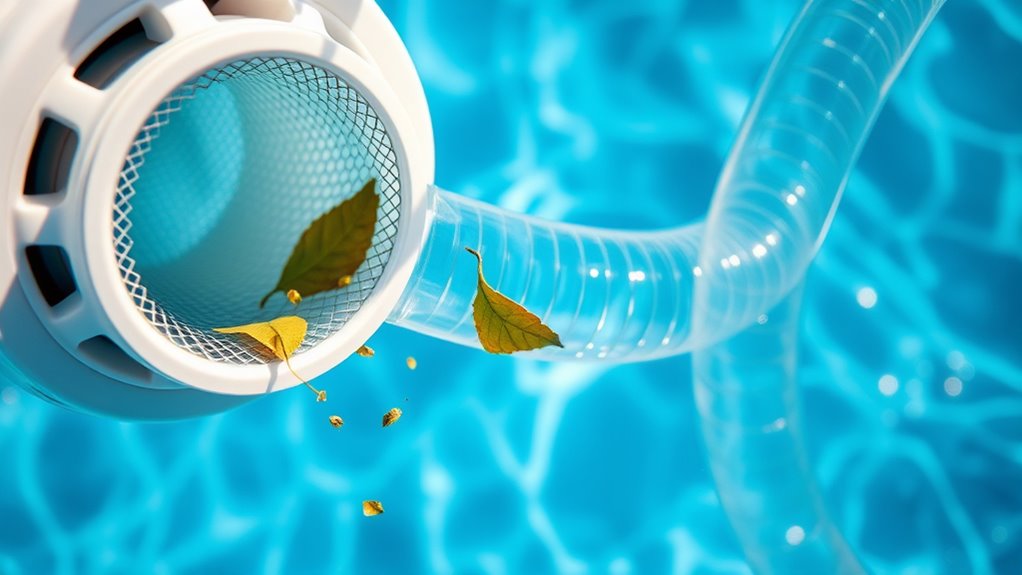
To keep your pool cleaner working efficiently, you need to regularly check the intake ports for any blockages. Make sure to remove debris from the suction path to prevent suction loss. Keeping these areas clear guarantees smooth operation and effective cleaning. Regular maintenance of your pool equipment can also extend its lifespan and improve performance through proper maintenance. Additionally, inspecting for any signs of wear or damage can further prevent potential malfunctions and ensure your pool cleaner operates at optimal efficiency. Since AI technology is increasingly integrated into various sectors, staying informed about AI safety measures can help you better understand how to protect your equipment and data.
Regularly Inspect Intake Ports
Regularly inspecting the intake ports of your pool cleaner is essential for preventing suction loss. During inspection, check the intake port for debris, dirt, or blockages that could hinder water flow. A clogged intake port reduces suction and affects cleaning efficiency. Make it a habit to examine the port before each use and clean it if necessary. Use a soft brush or cloth to gently remove any buildup around the intake port, ensuring unobstructed water flow. Keep an eye out for cracks or damage that might compromise the seal. Remember, a clean intake port maintains peak suction and prolongs your cleaner’s lifespan. Regular inspection helps identify issues early, preventing more significant problems later on. Additionally, monitoring for suction loss can help detect problems before they become severe. Understanding proper maintenance routines can further extend the life of your pool cleaner and ensure optimal performance. Incorporating routine checks for wear and tear can help catch deterioration early and ensure continuous efficient operation. To enhance your maintenance routine, consider checking the filter system regularly for debris buildup.
Remove Debris From Suction Path
Clearing debris from your pool cleaner’s suction path is vital for preventing suction loss. Regular debris removal ensures the cleaner operates efficiently and maintains proper suction. Start by inspecting the intake ports and suction hose for blockages, removing leaves, dirt, and other obstructions. Proper filter maintenance is also essential; a clogged filter can reduce water flow and cause suction issues. Clean or replace the filter as needed to keep water flowing freely. Check for debris buildup around the cleaner’s intake and remove any obstructions promptly. Keeping the suction path clear minimizes strain on the pump and prevents suction loss, ensuring your pool cleaner works effectively. Proper filter maintenance is crucial for optimal water flow and preventing clogs that can lead to suction loss. Regularly inspecting and maintaining the entire suction system can help identify potential issues early. Additionally, ensuring the pump performance is optimal can prevent unexpected suction problems. Consistent debris removal and filter maintenance are key to a trouble-free cleaning experience. Fostering supportive relationships encourages open communication and helps you address issues before they cause problems.
Verify the Pool Cleaner’s Filter and Debris Bag
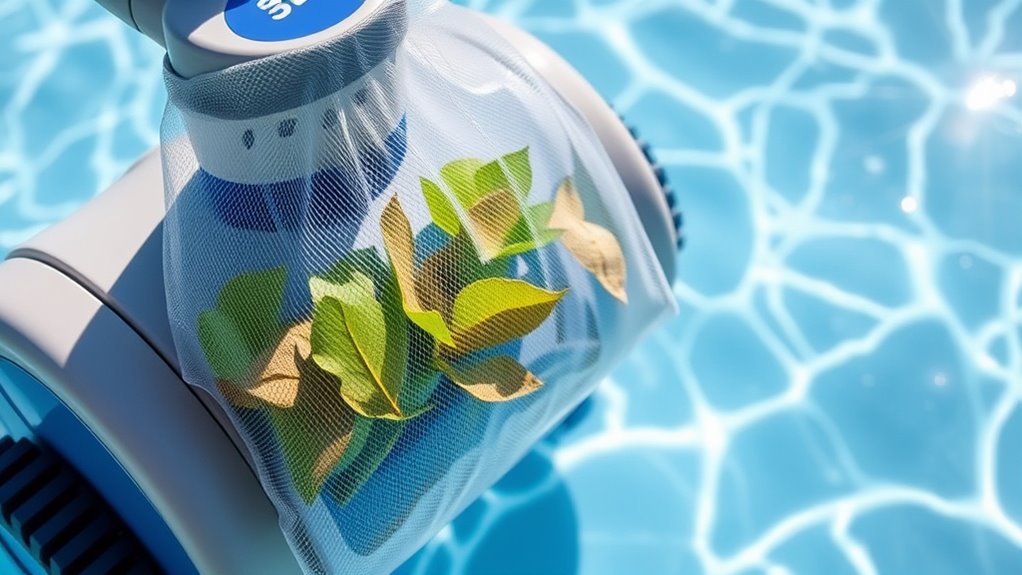
Make sure to check the filter and debris bag for blockages, as clogs can reduce suction. Regularly cleaning these components keeps water flowing smoothly and prevents loss of power. Keeping them clear is a simple step to maintain peak cleaning performance.
Check for Blockages
Since blockages in the filter or debris bag can cause suction loss, it’s important to scrutinize them regularly. Start by removing the debris bag and checking for clogs or buildup. Also, inspect the hose for any obstructions or kinks that could restrict water flow. If you notice a blockage, perform blockage removal promptly to restore proper suction. Remember to check the filter for debris or dirt that could be restricting water flow and reduce suction power. Regularly inspecting these parts helps prevent issues before they worsen.
- Remove debris from the debris bag
- Check for clogs in the filter
- Inspect hoses for kinks or obstructions
- Clear any debris blocking the hose
- Ensure proper fit of all connections
Regularly Clean Filters
Regularly cleaning your pool cleaner’s filter and debris bag is essential to maintain peak suction. A clogged filter restricts water flow, causing suction loss and reducing cleaning efficiency. Establish a cleaning schedule based on how often you use your cleaner and the debris level in your pool. During each cleaning, inspect the filter for dirt, leaves, and other debris, and rinse it thoroughly with a hose. If the filter appears worn or damaged, consider filter replacement to guarantee maximum performance. Keeping the filter clean prevents buildup that can block water flow and cause suction issues. By maintaining a consistent cleaning schedule and promptly replacing filters when needed, you’ll keep your pool cleaner operating smoothly and prevent suction loss.
Adjust the Pool Cleaner’s Float and Weight Settings
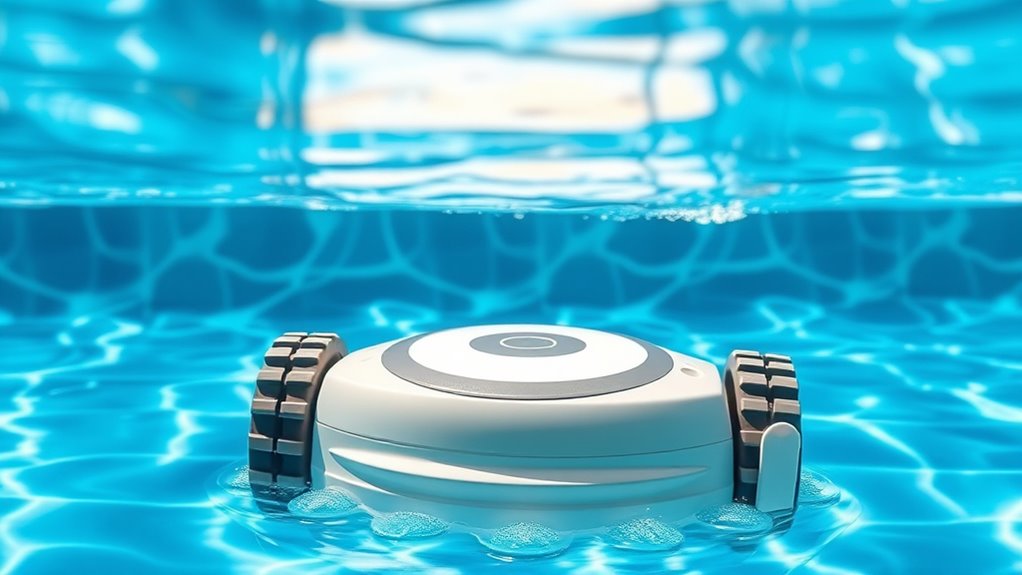
Adjusting the float and weight settings on your pool cleaner is essential for maintaining proper suction and maneuverability. Proper float adjustment ensures the cleaner stays at the right depth, preventing suction loss caused by improper positioning. Weight tuning helps the cleaner stay stable on the pool floor and avoid floating or sticking to walls. To optimize performance, experiment with the float and weight components as needed.
Here are some key ideas:
- Adjust the float to control the cleaner’s buoyancy
- Add or remove weights for better stability
- Ensure the cleaner doesn’t float too high or sink too low
- Check manufacturer recommendations for float and weight adjustments
- Regularly fine-tune your settings based on pool conditions
Proper float adjustment and weight tuning keep your cleaner working efficiently and prevent suction loss.
Regularly Maintain and Service Your Pool Pump System
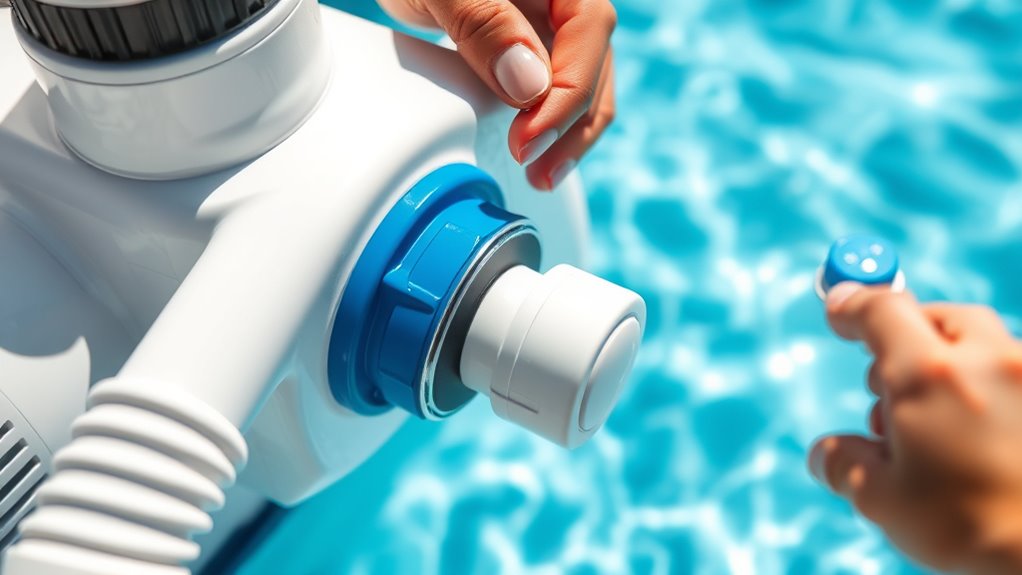
To keep your pool cleaner running smoothly and prevent suction loss, you need to prioritize regular maintenance and servicing of your pool pump system. Regularly check and clean the pump’s strainer basket to remove debris that can restrict flow. Keep your pool’s water chemistry balanced, as imbalanced pool chemistry can cause buildup and corrosion, affecting pump performance. Be mindful of weather effects; freezing temperatures or intense heat can damage components or lead to fluctuations in water pressure. Inspect the pump’s seals, hoses, and connections for leaks or wear, replacing parts as needed. Properly maintaining your pump ensures peak suction, reduces strain on your cleaner, and extends the system’s lifespan. Consistent upkeep is key to a trouble-free, efficient pool cleaning experience.
Confirm Correct Installation and Positioning of the Pool Cleaner
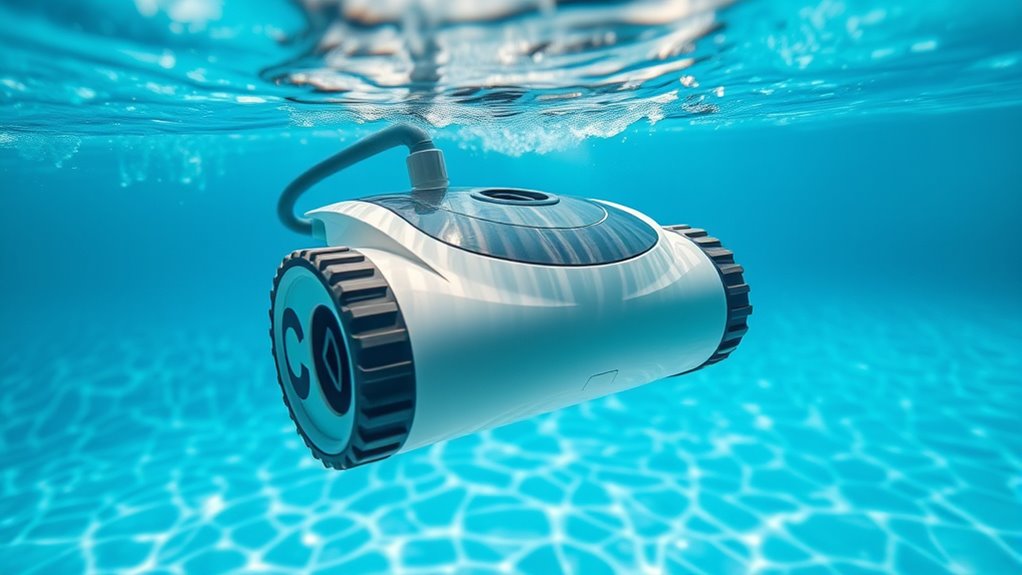
Ensuring your pool cleaner is correctly installed and positioned is essential for ideal suction and cleaning performance. Proper setup prevents suction loss and guarantees efficient operation across various pool cleaner types. Start by verifying the cleaner’s placement in the pool, making sure it’s not obstructed or tangled. Use the right installation tips for your specific cleaner model, whether robotic, suction-side, or pressure-side. Check that hoses and hoses connections are secure and free of kinks. Confirm the cleaner is floating at the correct depth, usually just below the water surface. Proper positioning promotes consistent suction and coverage, reducing the risk of suction loss. Regularly inspect and adjust the cleaner as needed to maintain optimal performance.
Proper installation and positioning ensure optimal suction and efficient pool cleaning performance.
- Confirm cleaner is free of obstructions
- Ensure hoses are securely connected
- Check for kinks or twists in hoses
- Position the cleaner at the right depth
- Follow manufacturer-specific installation tips
Use Proper Techniques When Connecting and Disconnecting the Cleaner
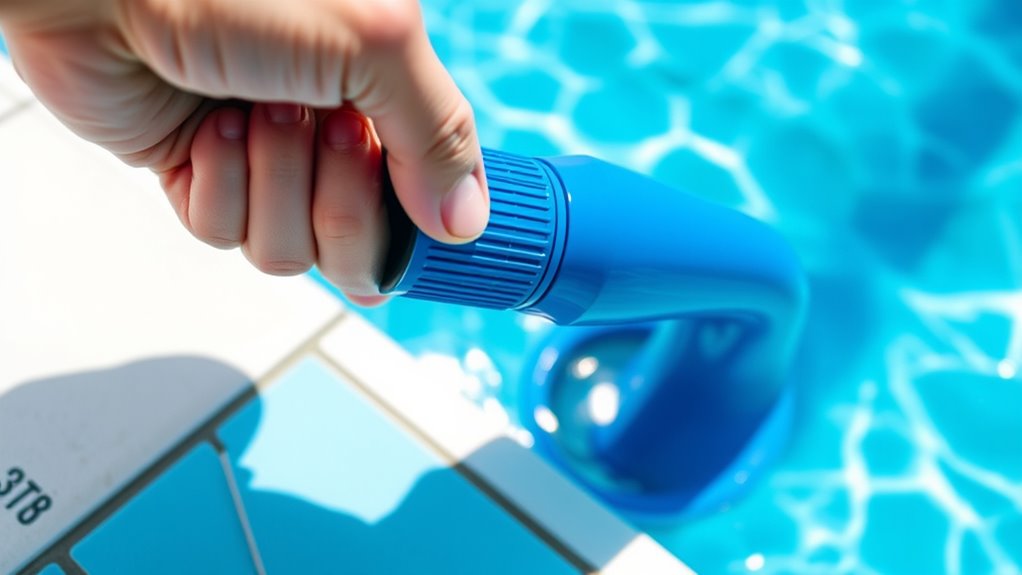
Properly connecting and disconnecting your pool cleaner is essential to maintaining peak suction and preventing damage. When making a proper connection, guarantee the hoses are securely attached without kinks or leaks, and that all fittings are tight. Follow the correct disconnect procedures by turning off the pump and power source first. Carefully detach hoses, avoiding force that could damage fittings or seals. Always check for debris or obstructions in the connections before reassembling. Proper connection prevents air from entering the system, which can cause suction loss. When disconnecting, do so gently to avoid damaging components. Consistently applying proper connection and disconnect procedures keeps your pool cleaner functioning efficiently and extends its lifespan.
Frequently Asked Questions
How Do I Identify if My Pool Cleaner Is Losing Suction?
If you’re wondering whether your pool cleaner is losing suction, look for signs like it struggling to vacuum debris effectively or moving sluggishly. Check the hose for leaks or cracks, as these can cause suction issues. Also, verify the connections are tight and the filter is clean. By inspecting these areas, you can quickly identify if your cleaner’s suction is compromised and take steps to fix it.
Can Algae Buildup Affect the Suction of My Pool Cleaner?
Imagine your pool cleaner gliding smoothly, but algae buildup and debris clogging create a slimy barrier, like a tangled web blocking its path. This buildup can reduce suction, making the cleaner struggle to pick up dirt. As algae thickens and debris accumulates, it hampers water flow, decreasing efficiency. Regularly brushing and cleaning your pool helps prevent algae buildup and debris clogging, ensuring your cleaner maintains strong suction and keeps your pool spotless.
What Are the Signs of a Faulty Pool Cleaner Motor?
If your pool cleaner isn’t working properly, you might notice signs of a faulty pool motor. Look for inconsistent cleaning, strange noises, or the cleaner stopping unexpectedly. Pool motor issues often stem from debris clogging the motor or wear and tear over time. Regularly inspect and clean the motor and debris catch basket to prevent damage. If problems persist, replacing the motor may be necessary to keep your pool spotless.
How Often Should I Replace the Seals in My Pool Cleaner?
You should replace the seals in your pool cleaner based on the seal maintenance and a regular replacement schedule. Typically, inspect the seals every 3 to 6 months, especially if you notice leaks or reduced suction. If you see cracks, brittleness, or damage, replace them immediately. Proper seal maintenance prevents suction loss and prolongs your cleaner’s lifespan, ensuring peak performance. Regular checks help you catch issues early and keep your pool spotless.
Does Pool Chemical Imbalance Impact Suction Efficiency?
Think of your pool’s chemical balance as the rhythm that keeps everything flowing smoothly. When your pool isn’t properly balanced, it can quietly weaken suction power, making cleaning less effective. Imbalanced chemicals can cause buildup or blockages, subtly hindering your cleaner’s performance. To keep suction power strong and consistent, regularly test and adjust your pool’s chemical levels. A well-balanced pool ensures your cleaner operates at peak efficiency, saving you time and frustration.
Conclusion
Think of your pool cleaner like a trusted partner—it needs regular check-ups to stay in sync. I once ignored a small leak, and soon my cleaner struggled to do its job. By keeping hoses tight, water levels right, and filters clean, you prevent suction loss and keep your pool sparkling. Remember, consistent care is like tuning an instrument; with a little effort, everything flows smoothly, and your pool remains a perfect oasis.
